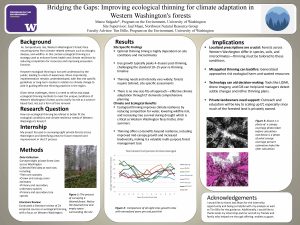Bridging the Gap: Improving Ecological Thinning Strategies in Western Washington for Climate Adaptation
Ecological thinning (ET) in Western Washington represents a crucial strategy for enhancing forest health and resilience in the face of escalating climate threats. ET practices in Western Washington have great potential for enhancing forest health and climate resilience but currently, there is insufficient site-specific research and refinement in the implementation of the process. Therefore, these operations frequently fall short of their potential, inadvertently increasing forests’ susceptibility to wildfire damage, root rot, wind damage, and invasive species. The purpose of this study was to identify perceived gaps in current ET practices and explore methods to refine these strategies effectively to combat climate change impacts in Western Washington Forest’s. During my internship, I conducted field studies across eight sites, collecting data related to forest thinning practices. My research involved analyzing this data to identify common trends and conducting a comprehensive literature review on ET processes, emphasizing the need for their refinement in response to climate change. My research highlights the critical need to expand regional and site-specific studies to better treat the diverse conditions of Western Washington forests. Implementing refined ecological thinning practices will significantly enhance forest resilience, reduce vulnerability to wildfire and disease, and support the preservation of biodiversity.
